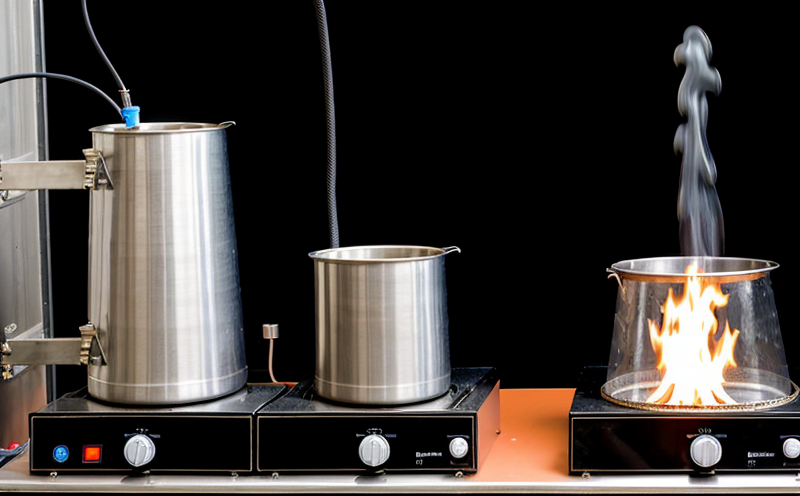Heat Release Testing of Textile Materials
The importance of heat release testing in textile materials cannot be overstated, especially given the increasing demand for safer and more resilient products. This type of testing is essential to ensure that textiles meet stringent safety standards and can withstand high temperatures without igniting easily or releasing excessive amounts of smoke and toxic gases. The test measures the rate at which a material releases heat when exposed to an external ignition source.
Heat release testing involves subjecting textile samples to controlled combustion in a calorimeter, where the amount of heat released is measured over time. This measurement helps determine the flammability characteristics of different materials, making it crucial for industries such as automotive, furniture, and residential products. Compliance with international standards like ISO 5636-2 or ASTM E662 ensures that textile manufacturers can meet regulatory requirements and ensure product safety.
The process typically begins by preparing the specimen according to specified dimensions and conditions. The sample is then placed into a calorimeter where it undergoes controlled combustion under specific environmental conditions, such as temperature, humidity, and pressure. Sensors within the calorimeter monitor various parameters including heat release rate (HRR), mass loss, and smoke production.
The data collected during these tests provides valuable insights into how different textiles behave when exposed to fire hazards. This information is critical for product development teams who aim to create safer products by selecting appropriate materials that meet both functional needs and regulatory expectations. By understanding the thermal behavior of a material through comprehensive heat release testing, manufacturers can optimize their designs while ensuring compliance with relevant regulations.
In summary, heat release testing plays a vital role in assessing textile flammability. It offers valuable information about how textiles respond to fire hazards under controlled conditions, which ultimately contributes towards creating safer products across various sectors including automotive interiors, furniture upholstery, and home furnishings. Properly conducted heat release tests not only enhance product safety but also contribute significantly toward meeting regulatory compliance requirements.
- Ensures compliance with international standards such as ISO 5636-2 or ASTM E662
- Provides critical data on flammability characteristics of textiles
- Assists in optimizing design choices for safer products
For quality managers, compliance officers, and R&D engineers involved in textile product development, heat release testing is an indispensable tool. It enables them to make informed decisions based on scientific evidence provided by the test results.
Eurolab Advantages
EuroLab stands out as a leading provider of heat release testing services for textile materials due to its state-of-the-art facilities, experienced technical staff, and commitment to delivering accurate and reliable results. Our clients benefit from our comprehensive understanding of international standards such as ISO 5636-2 and ASTM E662.
Our laboratory adheres strictly to these guidelines ensuring that all tests conducted are both consistent with industry best practices and compliant with regulatory requirements. This consistency ensures accurate comparisons between different materials tested, allowing manufacturers to confidently choose the safest options available.
- Absolutely Reliable Results: EuroLab uses cutting-edge equipment calibrated regularly to ensure precision measurements during each test
- Comprehensive Understanding of Standards: Our team stays up-to-date with all relevant international standards and guidelines, ensuring that our tests are accurate and compliant
- Experienced Staff: Our skilled technicians have years of experience in conducting heat release tests, providing clients with confidence in their results.
In addition to these technical advantages, EuroLab offers additional benefits such as quick turnaround times and personalized customer service. By choosing us for your heat release testing needs, you can rest assured that your textile materials will be evaluated thoroughly and accurately, helping you meet stringent safety standards while enhancing product quality.
Why Choose This Test
The decision to undergo heat release testing is one that should not be taken lightly. Not only does it provide invaluable data about the flammability characteristics of textiles but also helps manufacturers ensure their products meet strict safety standards set by regulatory bodies worldwide.
- Meets Regulatory Requirements: Compliance with international standards such as ISO 5636-2 and ASTM E662 ensures that your textile materials are safe for use in various applications
- Informs Design Decisions: By understanding how different textiles behave under fire hazard conditions, manufacturers can select the most appropriate materials for their products
- Enhances Product Safety: Accurate heat release testing helps reduce risks associated with flammable materials, contributing to overall product safety and consumer protection.
In today's competitive market where safety is paramount, choosing this test can give your business a significant edge. It demonstrates a commitment to quality and customer satisfaction while ensuring that you remain ahead of regulatory changes. Additionally, the detailed insights gained from heat release testing allow companies to innovate and improve their products continuously.
Competitive Advantage and Market Impact
Heat release testing is more than just a compliance requirement; it's an integral part of ensuring your textile products are safe and reliable. By conducting these tests, you gain a competitive advantage by demonstrating your commitment to quality and safety standards.
- Enhanced Reputation: Demonstrating compliance with international standards such as ISO 5636-2 or ASTM E662 builds trust among customers who value safety
- Innovation Opportunities: Understanding the thermal behavior of materials allows companies to innovate and develop safer, more effective products
- Regulatory Compliance: Ensuring that your textile products meet strict safety standards helps avoid costly recalls and legal issues
The market impact of heat release testing extends beyond individual businesses; it contributes positively to overall industry reputation. Consumers are increasingly aware of the importance of fire safety in textiles, leading to increased demand for safer products. By participating in rigorous heat release tests, companies contribute to this trend, helping to improve public confidence and drive positive change.
In conclusion, choosing heat release testing is not just about meeting regulatory requirements but also about positioning yourself as a leader in product safety and innovation within your market segment.





